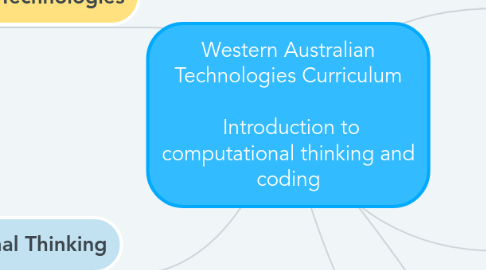
1. Design and Technologies
1.1. Computational Thinking
1.2. Foundation to year 2
1.2.1. Explore how technologies use forces to create movement in products (ACTDEK002)
1.3. Year 3 to year 4
1.3.1. Recognise the role of people in design and technologies occupations and explore factors, including sustainability that impact on the design of products, services and environments to meet community needs (ACTDEK010)
1.4. Year 5 to year 6
1.4.1. Investigate how electrical energy can control movement, sound or light in a designed product or system (ACTDEK020
2. What is Computational Thinking
2.1. Computational Thinking is a problem solving process that includes a number of characteristics and dispositions. It is essential to the development of computer applications. Students who learn computational thinking across the curriculum can begin to see a relationship between academic subjects, as well as between life inside and outside of the classroom.
2.1.1. Decomposition
2.1.1.1. Breaking down data, processes, or problems into smaller, manageable parts
2.1.2. Pattern Recognition
2.1.2.1. Observing patterns, trends, and regularities in data.
2.1.3. Abstraction
2.1.3.1. Identifying the general principles that generate these patterns
2.1.4. AlgorithmicAlgorythmic Design
2.1.4.1. Developing the step by step instructions for solving this and similar problems
3. ComputationalAssociations with Compuational Thinking
3.1. Problem Solving
3.2. Creativity
3.3. Communication
3.4. Collaboration
3.5. Computing
3.6. Critical Thinking
4. Digital Technologies
4.1. Coding
4.2. Foundation to year 2
4.2.1. Follow, describe and represent a sequence of steps and decisions (algorithms) needed to solve simple problems (ACTDIP004)
4.3. Year 3 to year 4
4.3.1. Identify and explore a range of digital systems with peripheral devices for different purposes, and transmit different types of data (ACTDIK007)
4.4. Year 5 to year 6
4.4.1. Design, modify and follow simple algorithms involving sequences of steps, branching, and iteration (repetition) (ACTDIP019)
